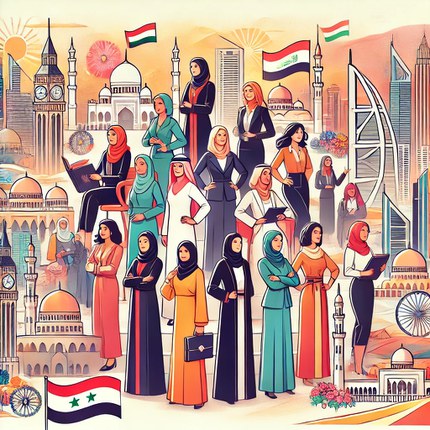Women’s Empowerment in the Middle East

Women’s empowerment is a cornerstone of sustainable development, driving social and economic progress worldwide. In the Middle East, a region with rich cultural traditions and diverse socio-political landscapes, the journey toward gender equality is marked by both significant advancements and persistent challenges. While recent reforms in countries like Saudi Arabia and the UAE reflect progress, challenges such as legal restrictions and societal norms in countries like Iran underscore the region’s complex dynamics. This analysis explores policy developments, social changes, and prospects for gender equality in the Middle East, with a focus on data-driven insights and case studies.
Several Middle Eastern countries have made significant strides in improving women’s rights in recent years, particularly through legal reforms and increased labor market participation. Saudi Arabia has undertaken transformative measures, including granting women the right to drive, travel without male guardians, and work in previously restricted sectors. The Vision 2030 initiative has been a critical driver of these changes, resulting in women’s labor force participation rising from 20% in 2018 to 37% by 2023 (World Bank, 2023). Similarly, the UAE has introduced legislation mandating equal pay, promoting female entrepreneurship, and ensuring 50% female representation in the Federal National Council, reflecting a commitment to political inclusivity (United Nations Development Programme [UNDP], 2022).
Education has also been a key enabler of women’s empowerment in the region. Female enrollment in higher education surpasses male enrollment in countries like Qatar, the UAE, and Saudi Arabia, with an increasing number of women entering STEM fields (OECD, 2022). Political representation is gradually improving, as evidenced by Tunisia’s 2021 parliamentary elections, where 47% of seats were held by women, driven by a gender quota system (Inter-Parliamentary Union, 2021). These advancements highlight a growing recognition of the role of women in governance and economic development.
Despite these achievements, significant challenges persist. Restrictive laws and social norms continue to hinder gender equality in several countries. For example, in Iran, the mandatory hijab law and restrictions on women’s freedoms have sparked widespread protests and global advocacy efforts. The “Women, Life, Freedom” movement, ignited by the death of Mahsa Amini in 2022, underscores the resilience of Iranian women in the face of systemic discrimination (Amnesty International, 2023). Additionally, patriarchal traditions across the region perpetuate issues such as child marriage, domestic violence, and unequal inheritance laws, limiting women’s access to opportunities.
Workforce participation remains a significant barrier for women in the Middle East. Factors such as limited access to childcare, wage gaps, and occupational segregation exacerbate gender disparities. For example, women in the region earn approximately 22% less than men for comparable roles, according to the International Labour Organization (ILO, 2022). Cultural stigmas around women working in public-facing roles further constrain their economic contributions, particularly in more conservative societies.
Saudi Arabia’s recent reforms provide a case study of progress in women’s rights. Initiatives like eliminating guardianship restrictions for specific activities, expanding access to traditionally male-dominated industries, and promoting women’s entrepreneurship have redefined gender roles. However, challenges such as wage disparities and underrepresentation in leadership positions highlight the need for sustained efforts (World Economic Forum, 2023). In contrast, Iran exemplifies the ongoing struggle for gender equality. Despite high literacy rates and significant contributions by women in academia, systemic discrimination persists. The protests sparked by the mandatory hijab law illustrate both the challenges and the potential for transformative change driven by grassroots advocacy.
Looking ahead, several areas require further improvement to close gender gaps in the Middle East. Governments must address legal inequalities, enhance access to reproductive healthcare, and promote women’s entrepreneurship through targeted policies and financial incentives. Strengthening mechanisms to combat gender-based violence and ensuring workplace equality are also critical. Civil society organizations play an essential role in advocating for these changes. Grassroots movements and NGOs have been pivotal in raising awareness and providing support to marginalized women. International organizations like the UN and World Bank offer technical and financial assistance to advance women’s empowerment in the region (UN Women, 2022).
Women’s empowerment in the Middle East is a dynamic and multifaceted journey, reflecting both progress and persistent challenges. Legal reforms, educational advancements, and increased political participation signal a shift toward greater gender equality. However, social and legal barriers underscore the need for sustained efforts. By prioritizing inclusive policies and leveraging the influence of civil society, the region can build a future where women fully contribute to its social and economic development.
Jana Al Sahily
